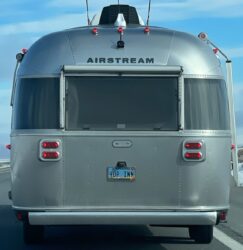So since we’re talking about Plan B situations on our coast to coast journey, let’s discuss network connectivity. Doing the digital nomad thing is great as long as you can connect to the rest of the world. For my first attempt, I failed twice with the Netgear Nighthawk M1 Mobile Hotspot Router. (TLDR spoilers: Amazon link here but who cares because it’s crap and don’t buy it.)
The fail started pretty fast even before we left. The idea with this router is you take any ol’ SIM card with a data plan (in my case, liberated from Fox’s iPad Pro 1st gen, an AT&T legacy unlimited plan, mmmmm….), drop it in the device, set up a little hotspot with the web page or app, voila. Instant internet anywhere.
What I got instead was a failure to charge the battery because the device was too hot. In Las Vegas. At 85º F. WTF. So this device wasn’t going to be the long term live in the Airstream and enjoy the multitude of USB charger ports available. Okay.
Next failure – The critical role of a hotspot is to BE A HOTSPOT. This one didn’t. After a little while of being turned on, it just decided…. nah man, we coo. It didn’t shut off, it just stoped providing any sort of connections. Not for lack of signal, the SSID just wouldn’t appear to any devices. You’d need to hard reboot the device with a battery removal to get the thing to respond anymore.
So, maybe just a bad unit, right? Swappy swappy time with Amazon. New unit arrives via Amazon Prime to my delusional uncle’s house who doesn’t understand why Trump is sending him random packages with license plates and electronics even though the label clearly says FOR SEAN on it…. ANYWAY. New boss, same as the old boss.
Maybe it was just losing AT&T (more bahs in more places…), and I needed a better antenna? Oh, Amazon. Your Netgear MIMO antenna in “retail packaging” was TWICE sent as a display model with clearly noted on the packaging that it was not for sale.
Plan B
So, buh bye went the Netgear. And I found https://mofinetwork.com on Amazon instead. This is NOT a simple router. This appears to be a full linux install in a small ruggedized box with metal enclosure, two cell antennas, two 2.4GHz antennas, and a sweet 12 volt adapter with a fuse tap for always on network. Now have successfully done multiple meetings from I-95 from the truck (where the router is a good 35′ away while driving down the highway). This one has been a winner so far.

